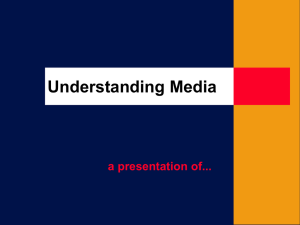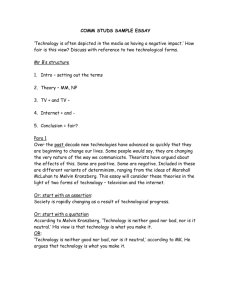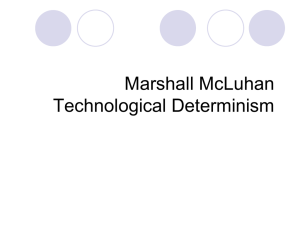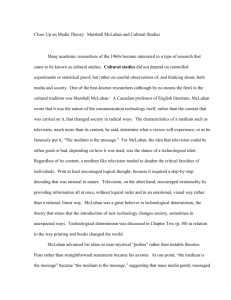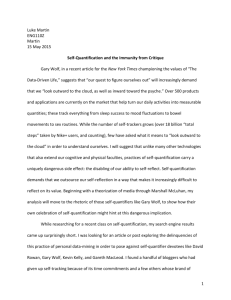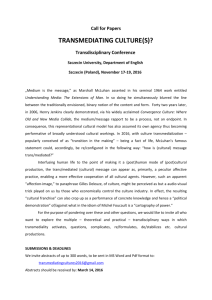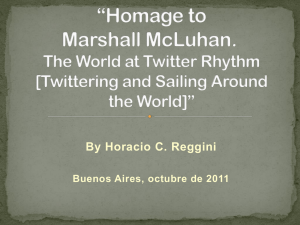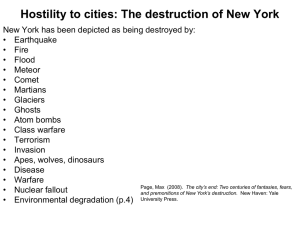What Haven't You Noticed Lately
advertisement
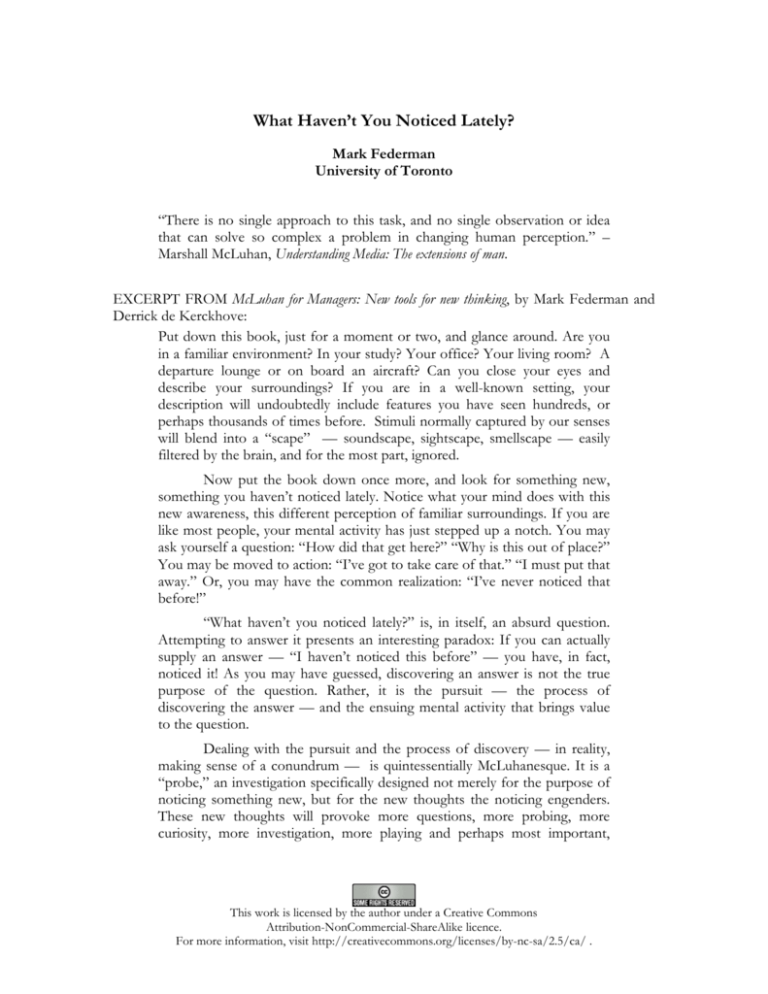
What Haven’t You Noticed Lately? Mark Federman University of Toronto “There is no single approach to this task, and no single observation or idea that can solve so complex a problem in changing human perception.” – Marshall McLuhan, Understanding Media: The extensions of man. EXCERPT FROM McLuhan for Managers: New tools for new thinking, by Mark Federman and Derrick de Kerckhove: Put down this book, just for a moment or two, and glance around. Are you in a familiar environment? In your study? Your office? Your living room? A departure lounge or on board an aircraft? Can you close your eyes and describe your surroundings? If you are in a well-known setting, your description will undoubtedly include features you have seen hundreds, or perhaps thousands of times before. Stimuli normally captured by our senses will blend into a “scape” — soundscape, sightscape, smellscape — easily filtered by the brain, and for the most part, ignored. Now put the book down once more, and look for something new, something you haven’t noticed lately. Notice what your mind does with this new awareness, this different perception of familiar surroundings. If you are like most people, your mental activity has just stepped up a notch. You may ask yourself a question: “How did that get here?” “Why is this out of place?” You may be moved to action: “I’ve got to take care of that.” “I must put that away.” Or, you may have the common realization: “I’ve never noticed that before!” “What haven’t you noticed lately?” is, in itself, an absurd question. Attempting to answer it presents an interesting paradox: If you can actually supply an answer — “I haven’t noticed this before” — you have, in fact, noticed it! As you may have guessed, discovering an answer is not the true purpose of the question. Rather, it is the pursuit — the process of discovering the answer — and the ensuing mental activity that brings value to the question. Dealing with the pursuit and the process of discovery — in reality, making sense of a conundrum — is quintessentially McLuhanesque. It is a “probe,” an investigation specifically designed not merely for the purpose of noticing something new, but for the new thoughts the noticing engenders. These new thoughts will provoke more questions, more probing, more curiosity, more investigation, more playing and perhaps most important, This work is licensed by the author under a Creative Commons Attribution-NonCommercial-ShareAlike licence. For more information, visit http://creativecommons.org/licenses/by-nc-sa/2.5/ca/ . Federman What Haven’t You Noticed Lately? more thinking. In search of the unnoticed, a person gains new perception and awareness about the present environment, surroundings and conditions. In a business environment, managers seldom have difficulty with familiar and comfortable surroundings — business as usual, steady production, healthy revenue, growing profit, happy customers, competitors held at bay. When the surroundings become less familiar and friendly, managers become worried and seek quick solutions to restore the former status quo. Immediate corrective action is frequently demanded by impatient shareholders and boards of directors. The imperative is to do anything, so long as it is quick and will provide some symptomatic relief before issuing the next quarterly results. As a result, there is precious little time to search for root causes and determine an appropriate path to a sustainable solution. There is also no time to consider possible secondary and tertiary effects that may result from imposing quick action. And most certainly, there is no time to notice that which has not been noticed lately. It seems that all a manager needs these days is a way of predicting the future. If the manager, facing a myriad of challenges, were merely able to predict the outcomes of actions and the future effects of decisions taken now, all else would unfold as it should. For example, what if someone could have considered the nature of radio and television from the 1950s through the 1970s, and subsequently predicted the extension of such instantaneous communication into today’s Internet? What if he or she could have predicted the effects of instantaneous communications on business, culture and society in general? And, what if business actually heeded those predictions and used them to tactical or strategic advantage? Now, imagine if that someone were available to sit with business managers today. Together, they would consider difficult and challenging problems and apply the same thinking tools and techniques that were used to predict the effects of an embryonic Internet, as Marshall McLuhan did over forty years ago. At the beginning of this chapter, we proposed a simple exercise in perception: Notice something new or different in a familiar surrounding, something you haven’t noticed lately. In one sense, a very familiar environment is quite homogeneous — nothing in particular stands out as unique or worthy of special notice. If you were able to notice something new or distinct, you actually observed a figure — the new — against its ground — the familiar. In this instance what made the observed item or situation new is precisely the familiarity of the rest. It was the particular familiarity with your surroundings that provided the context within which “what you haven’t noticed lately” existed and had meaning as a distinct entity. McLuhan told us that nothing has meaning by itself. Something may exist in isolation, but its meaning — and by extension, its value — is derived solely as a function of the context or environment in which it exists. 2 Federman What Haven’t You Noticed Lately? Figure and Ground FIGURE IS what you notice. Ground is everything else. Ground is your life story, your culture, where you went to school, what your parents believed, where you work, where you play, what you had for breakfast, the place in which you’re reading this article. In fact, there are so many aspects that comprise your ground, that they are pretty much impossible to enumerate completely. Fortunately, most aspects that comprise your personal ground, or context from which you make meaning, are not as influential as the few that are most important. As well, many aspects that make up your ground also contribute to the ground of people with whom you associate, work, play, and collectively make meaning in the world – or at least, the small part of the world that you inhabit. The problem is that most of us take all those ground aspects for granted. In particular, we typically don’t recognize the effects that these various ground aspects have on us, on those around us with whom we interact, and on our collective perception, interpretation and understanding of the things that we do notice. Our entire purpose in using these new methods in perception and thinking is to reveal these hidden or unnoticed aspects. In making these various ground aspects explicit, it becomes possible to observe previously unnoticed effects, and how they might affect us. Figure is what you notice. Ground is everything else. We create meaning and make sense of things when figure interacts with ground. Think about this example from McLuhan for Managers: Consider a student with limited job-related programming skills. Taken as a figure in isolation, no judgement can be made about the student, as there is no context against which the attributes of the student can be measured. Furthermore, the relevance of the student’s attributes to the particular situation cannot even be determined, since we have provided no pertinent information. In other words, a figure out of context, in isolation, has no meaning. Now take a moment and contemplate the figure of the student cast against the following work scenarios as ground: • The student is the only programmer set to work on a business critical production application by a penny-pinching company that could otherwise afford to pay for experience. • The student is hired by a university research project to work on experimental development related to his or her studies. • The student is a close relative of the company’s president. • The student is a close relative of the company’s largest customer’s president. • The student is part of a large development team working on a businesscritical production application. She has been hired by a company that tends to recruit fulltime employees from among prior interns. Each scenario provokes a distinct managerial reaction: positive, negative or neutral. In each, the student did not change but the context did. In changing the ground, the advisability of the decision to place the student 3 Federman What Haven’t You Noticed Lately? in the particular employment situation also changed from one scenario to the next. In other words, our perception of the situation changed by virtue of the context. In this excerpt, the ground or context changes in each scenario, and the manager perceives a different meaning. In life, grounds are constantly changing and always in flux. For much of our day-to-day life, the ground appears to be relatively stable. But, over time, the ground – the mostly unnoticed ground – shifts, and so too must the meaning that we make of the world. Thus, the task before us is relatively simple to state: how can we learn to see the unseen, to notice what is unnoticed, and to ask the unasked questions after we’ve asked everything we can think of. Only then can we truly make sense of our world. How important is noticing what may be obvious, but hidden? Once there was a man who, during wartime, would come to the country’s border with a wheelbarrow full of dirt. The border guard looked at the man’s papers and all was in order for him to cross. But the guard was certain the man was smuggling some sort of contraband in the wheelbarrow. So the guard took a shovel, poked around in the dirt, but found nothing. The man was allowed to cross. The next week, the man once again comes to the border with a wheelbarrow full of dirt. Again, the border guard found that the papers were in order and dug through the dirt, but still found nothing. And again, the man was allowed to cross. Week after week, it was the same story: man approaches the border with a wheelbarrow full of dirt; guard finds nothing of interest and the man crosses. Time passes and the war ends. One day, in a nearby town, the guard sees the man. The guard confronts him and says, “You used to come to my border crossing every week pushing your stupid wheelbarrow full of dirt. Look, I know you were smuggling something across the border, but I could never find anything hidden in the dirt. What were you smuggling all those years?” The man looks up at him, smiles and answers, “Wheelbarrows.” The guard was unable to perceive what had been right under his nose for all that time, simply because it did not match his conception. Preconceived, fixed notions about how the world is – or worse, how the world was – often place self-imposed, arbitrary limitations on our ability to observe and to think. And that brings us to understanding the medium, the message, and how upending your preconceptions about both might just open a whole new way of perceiving the world. The Medium and the Message FROM McLuhan for Managers: “The Medium is the Message” is undoubtedly the single, most well known of the multitude of Marshall McLuhan’s sayings. And, it is most assuredly among the most misunderstood. Like Albert Einstein’s famous relativity equation, E = mc2, few people who have heard the McLuhan Equation, Medium = Message, understand what it means, and its implications and consequences. 4 Federman What Haven’t You Noticed Lately? To most people, the media are information channels, most commonly the press, television, radio and the Internet. The message of a medium is most often mistaken as the information content it conveys. From McLuhan’s perspective, our conventional examples of media are for the most part correct, but not for the reasons we would immediately guess. As for our understanding of message, the popular view could not be further from what McLuhan had in mind. In McLuhan’s world a medium is anything that extends our mind, body or senses. It could be a new technology or gadget. It could be a new process. An idea or original, creative work is a medium. Anything we create or build, anything we conceive, any expression of humankind is a McLuhanesque medium. Media — more than one medium — can be concrete and tangible or they may be abstract and intangible. Examples are easy to find, and indeed, Marshall McLuhan offered them. Clothing is an extension of our skin. The motorcycle is an extension of the bicycle, which itself extends our leg and foot. The microphone and radio are both extensions of our voice. What we conventionally conceive of as the media — the press, radio, television, and so forth — are examples of McLuhan’s perception of media, extending our ears and eyes to the world, expanding the reach of voices and the influence of ideas… Before stepping into the world as perceived by McLuhan, our conventional view has been that media were simply channels for conveying information. Information comes from outside of our direct sensory experience, via media channels, to the inside of our minds. For example, when we read about an event in the press, we do not experience it directly. Seeing fireworks on television is distinctly different than feeling the compression of the explosion and marvelling at the night sky lit with a multitude of colours. We often view the bombardment of multiple media as just that — multiple incessant channels of information that inundate us. To be sure, the flood of information is often extreme; some even feel compelled to turn it off. Unplug the television! Turn on the answering machine and ignore the messages! Throw away the cell phone! Turn off the computer! It’s little wonder that so many people identify with the popular television and advertising image of computers being thrown from high-rise office windows. Others cope by simply casting the flow of information to the McLuhanesque ground, considering it — or rather, not considering it at all — as the blur it appears to be. The torrent of information takes on the characteristics of wallpaper, providing merely a backdrop for modern life that is easily ignored. This typifies information overload, the bane of modern business, managers and our modern, western society in general. Why does information overload happen? The easy response may be that we simply have too much exposure to the media. But McLuhan reminds us that we are literally surrounded by media — everything we have created, fabricated, or conceived – every idea, every work of art, music and literature, 5 Federman What Haven’t You Noticed Lately? our homes, our companies, our institutions – they are all media. Clearly, “too much media” is not the root of our feelings of frustration, desperation and despair. Rather, we have become too enamoured with, focused on, and vested in information – the content of the media. Why do you think it’s called information overload in the first place? McLuhan has some advice on what to do with the content. However, before we get to that, knowing that message does not equal content is fundamental to understanding the McLuhan Equation, “the medium is the message.” Mistaking medium as merely a conveyance of content limits one’s thinking, causing us to ignore the true nature of the medium. In one sense, the message is anything and everything but the content! In our developing new perspective on the world, the message of a medium is the resultant “change of scale, pace or pattern” that a medium causes in ourselves, in society or in a culture. This is clearly distinct from the content of the medium. This seemingly obscure view is based on the notion that the information itself is not necessarily what is important to understand or appreciate the nature, power and potential of the medium. The medium’s ability to effect change is what is important to realize and understand. In his book, Understanding Media, McLuhan tells us that a message is, “the change of scale or pace or pattern” that a new invention or innovation creates in human interactions. Note that it is not the content or use of the innovation, but the change in interpersonal dynamics that the innovation brings with it. Thus, the message of theatrical production is not the musical or the play being produced, but perhaps the change in tourism that the production may encourage. In the case of a specific theatrical production, its message may be a change in attitude or action on the part of the audience that results from the medium of the play itself, which is quite distinct from the medium of theatrical production in general. Similarly, the messages of a newscast are not the news stories themselves, but a change in the public attitude towards crime, or the creation of a climate of fear. A McLuhan message always tells us to look beyond the obvious and seek the non-obvious changes or effects that are enabled, enhanced, accelerated or extended by the new thing. McLuhan defines medium for us as well. Right at the beginning of Understanding Media, he tells us that a medium is “any extension of ourselves.” Classically, he suggests that a hammer extends our arm and that the wheel extends our legs and feet. Each enables us to do more than our bodies could do on their own. Similarly, the medium of language extends our thoughts from within our mind out to others. Indeed, since our thoughts are the result of our individual sensory experience, speech is an "outering" of our senses – we could consider it as a form of reversing senses – whereas usually our senses bring the world into our minds, speech takes our sensorially-shaped minds out to the world. But McLuhan always thought of a medium in the sense of a growing medium, like the fertile potting soil into which a seed is planted, or the agar in a Petri dish. In other words, a medium – this extension of our body or senses or mind – is anything from which a change emerges. And since some sort of change emerges from everything we conceive or create, all of our inventions, innovations, ideas and ideals are McLuhan media. Thus we have the meaning of “the medium is the message”: We can know the nature and characteristics of anything we conceive or create (medium) by virtue of the changes – often unnoticed and non-obvious changes – that they effect (message.) As McLuhan states 6 Federman What Haven’t You Noticed Lately? in Understanding Media, “This is merely to say that the personal and social consequences of any medium – that is, of any extension of ourselves – result from the new scale that is introduced into our affairs by each extension of ourselves, or by any new technology.” Although we often pay attention to the media or things themselves (or more often, to the content of the things), it is the effects or messages that are most easily observed. Some people might say that we are biologically wired to observe effects. For example, we don’t need to see the tiger; we only have to see movement in the underbrush, or hear rustling in the bushes to know to start running! Or, think of it as a sort of McLuhan-Zen koan: what does the wind look like? We can certainly see the effects of the wind, from leaves and branches swaying all the way up to roofs being torn from buildings. We don’t actually have to see the wind to understand its effects. As it turns out, it is the study of effects or messages that help us to discover hidden grounds. Having All the Answers is One Thing Having the Right Questions is Quite Another “Clear out the experts… The expert doesn’t know the right questions, so he rejects the right answer. Hence the need for a playful and spontaneous approach to real problems.” – Marshall McLuhan, Take Today: The executive as dropout. THINK ABOUT this: if we can know the nature and characteristics of any medium – anything we conceive or create – by virtue of its effects, are there a small set of effects or messages that are common to all media? If so, we could classify what is, or is not, a medium according to whether it satisfied those particular effects (quite apart from any other effect that it might create). Marshall McLuhan set out to find such a set in the 1970s, an endeavour that occupied the remainder of his life. Marshall McLuhan, together with his son, Eric, proposed four laws of media. They maintain that the laws apply without exception to all creations of humankind, whether tangible or intangible, abstract or concrete. They also claim that there are precisely four laws that reveal the nature of any medium and challenge readers to find an example that possesses only three attributes, or a fifth that applies in every case. Not surprisingly, the laws of media are framed as questions or probes. What does the Medium extend, enhance, intensify, accelerate or enable? This can be asked concerning anything we create or conceive, be it tangible, intangible, abstract or concrete. It applies equally to wastebaskets, weddings and words; laws of the state or laws of physics. For example, joking or wit as a medium enhances playfulness, good feelings, and inclusiveness. If some aspect of a Medium is extended or enhanced, the old condition is simultaneously displaced. What is obsolesced by the new medium? This does not mean it is eliminated, merely that it has lost the “effect-iveness” it once had. Joking, for example, obsolesces seriousness and solemnity. As the medium enhances some aspect, it recalls or brings back a long-obsolesced aspect of an earlier medium or ground. What does the medium retrieve from the past that had previously been obsolesced? For instance, as “laughter is the best medicine,” joking might retrieve healing, or mending previously damaged relations. When the medium is extended to, or beyond, the limits of its potential, it will tend to reverse its original characteristics into a complementary or opposite form. Into what does 7 Federman What Haven’t You Noticed Lately? the medium reverse? When joking goes “beyond the limit,” good feelings can reverse into conflict and hurt. Extend. Obsolesce. Retrieve. Reverse. All of these effects occur in the medium at once, simultaneously. It is not that one or the other occurs at different times, nor does one cause or lead to another. All of the effects are present and reflect the systemic nature of the effects of a medium. They all act together, coming into effect the moment the medium is created and begin to affect us and other media with which the given medium interacts. To emphasize this simultaneity of effects, McLuhan arranges the probes as four quadrants of a tetrad: What does the medium EXTEND, enhance, intensify, accelerate or enable? When extended beyond its limits, into what does the medium REVERSE? What formerly obsolesced form does the medium RETRIEVE from the past? What does the medium OBSOLESCE or displace in its former dominant effect? Here’s an example of a tetrad that analyzes the medium of the car: CAR EXTENDS, ENABLES 1 2 REVERSES INTO 3 1,2 Travelling , Privacy , Status , Speed and 4 5 carrying capability , Urban sprawl 1,2 Traffic jams , Public transit , 3 4 5 Egalitarianism , Energy crisis , Suburbs , 5 Telecommuting 1,2 1 Sedan chairs , Servant class 3 4 (mechanics, car washers) , Horsepower , 5 Wanderer or nomad 2 3 Walking , Public persona , Humility , 4 Sense of human scale , Neighbourhoods 5 and sense of community RETRIEVES OBSOLESCES Although all the items in every quadrant relate to a car, each one also relates to some context or ground, relative to which that item makes sense, and gives some sort of 8 Federman What Haven’t You Noticed Lately? interpretation or meaning to the car. For example, cars both extend our ability to travel, and enable urban sprawl. However, the ground of travelling or transport could be considered as a separate and distinct context from that of community or urbanization. Each superscript indicates elements with common grounds; those grounds might be described as (1) travelling or transport; (2) personal space; (3) social position; (4) power; and (5) locale. Another person with a different life history and experience might describe the commonalities differently because their associations with car – not to mention space, status, power or location – could be quite different from mine. Nonetheless, commonalities among individual items themselves across the four tetrad quadrants are relatively easy to derive once the effects themselves have been enumerated. On the other hand, if you were asked right up front to “please identify the various contexts in which a car has meaning,” you might look rather askance at the questioner. For any given medium, all four elements of the tetrad are always present. If you can observe a reversal relative to a particular ground, for instance, then at least one extension, obsolescence and retrieval exist relative to that same ground. This rule enables us to use the tetrads in what might appear to be a predictive fashion. Even if we have yet to observe a specific effect, we can “predict” its presence and attempt to characterize it by virtue of the existence of other common-ground effects. For example, if we identify characteristics for three relatively conspicuous tetrad aspects, the tetrad suggests the existence of the fourth, less evident effect. More often than not, we will discover that it is this latent or unnoticed effect that holds the most potent message of the medium under consideration. If they remain unnoticed, these often become known as “unintended consequences.” McLuhan Media Magic: Seeing the Invisible, Finding the Hidden, Observing the Unnoticed “Everybody experiences far more than he understands. Yet it is experience, rather than understanding that influences behavior, especially in collective matters of media and technology, where the individual is almost inevitably unaware of their effect upon him.” – Marshall McLuhan, Understanding Media. IN THIS quotation, McLuhan offers an interesting observation, as well as a tacit challenge: how do we tap into the wealth of wisdom that is our collective experience, rather than merely our processed, frequently pre-conceived, and often well-rehearsed, understanding? What we’re really interested in obtaining are percepts, not concepts (or even precepts, for that matter). A commonly used way of harvesting ideas that are in people’s minds is called brainstorming, and it comes in various guises, permutations and techniques. Most often, under the direction of the best facilitator the budget can afford, a group fills flipchart pages with ideas and flashes of insight. The process is often exciting and exhilarating for the participants as one person’s creativity and imagination seems to feed on another’s. With apologies to the movie from 2000, this is The Perfect Brain Storm: ideas are tossed this way and that by the power of the creativity deluge that results when several powerful idea-fronts convene and collide. Those participating are whisked along in their enthusiasm for the task carried by gales of hot, humid air. The outcome is often mixed. At the end, some participants are truly enthusiastic and invigorated by the promise of the session. Others, perhaps more cynical about the process, may feel frustrated by the results or the direction of the discussions. There may be a few who are simply confused and maybe frightened by the prospects of change. 9 Federman What Haven’t You Noticed Lately? Experience shows that much of what was accomplished during the brainstorming session will ultimately have little lasting impact or value. Many ideas that arise from these events will prove to be ill-conceived, trivial or unusable in practice. Many will be mere extrapolations or extensions of current business-as-usual. Inevitably, there will be ideas that remain locked up in people’s minds that will never appear on a flipchart because the person did not want to appear foolish, or because they represent unpopular opinions, or because there are silent power dynamics at play from the boss’s omnipresent influence. Brainstorming is subject to a basic fallacy: it depends on gathering together all the current ideas that people already have (and hold, and often cherish), and throwing them together in one big metaphorical pot. What brainstorming doesn't have is a mechanism to discover the ideas that haven't been thought-of once everyone's brains have been tapped for all their content. What's more, any dysfunctional office dynamics and interpersonal power plays are unavoidably brought into the brainstorming session; there is nothing inherent in mechanism of brainstorming to disarm the overbearing self-appointed leader, the controlloving narcissist, the zero-sum gamer, and other similarly disruptive characters. Additionally, because most of us have been well-trained and socialized in dichotomous thinking – right vs. wrong, pro vs. con, upside vs. downside, advantage vs. disadvantage – traditional brainstorming cannot deal with many of the problems that occur so frequently in business and elsewhere, such as: • Mutual exclusivity of ideas and denial of paradox, also known as the “zero-sum game”; • “Preclusive” thinking, in which believing is seeing – if I don’t believe it, I can’t see it; • Hierarchical hegemony, in other words, the boss is always right, especially when he’s wrong; • “Deer in the headlights” syndrome, resulting from a total focus on figure, and an inability to see the ground, also known as tunnel vision; • “Unintended consequences,” that should be more appropriately called unanticipated consequences arising from a lack of awareness and perception of effects. This is where the thinking framework of the Laws of Media tetrads comes in. By using the Laws of Media tetrad to "sort" the various seed ideas – the ones that people bring with them to the session that end up on the flipchart in the first round – what has been missed immediately becomes evident. Both the missed grounds, and the missed aspects stick out like big neon signs, flashing, "Here are the ideas we haven't yet thought of!" What's more is that the need to dominate, or to prove the rightness of your idea (or the wrongness of someone else’s) is automatically disarmed by the elimination of dichotomous value judgments, and the other problems noted above. Because of its focus on the totality of effects, tetrad-enhanced brainstorming can effectively eliminate the limitations inherent in traditional methods, thereby revealing what you haven’t noticed lately. For Additional Reading Federman, M. (2004, 2004/07/23). What is the Meaning of the Medium is the Message?. Available from http://www.mcluhan.utoronto.ca/article_mediumisthemessage.htm. 10 Federman What Haven’t You Noticed Lately? Federman, M. (2006, 2006/06/25). Creating a Culture of Innovation. Available from http://individual.utoronto.ca/markfederman/CultureOfInnovation.pdf. Federman, M., & de Kerckhove, D. (2003). McLuhan for Managers: New tools for new thinking. Toronto: Viking Canada. McLuhan, M. (1964). Understanding Media: The extensions of man. Toronto: McGraw-Hill. McLuhan, M., Fiore, Q., & Agel, J. (1967). The Medium is the Massage: An inventory of effects. New York: Bantam. McLuhan, M., & McLuhan, E. (1988). Laws of Media: The New Science. Toronto: University of Toronto Press. McLuhan, M., & Nevitt, B. (1972). Take Today: The executive as dropout. New York: Harcourt, Brace, Jovanovich, Inc. About the Author AN UNCONVENTIONAL, yet strategic thinker, Mark Federman has more than twenty-five years’ experience in the high-technology industry as executive, manager and consultant, spanning disciplines including research and development, marketing, sales, operations and strategic leadership. Until recently, Mark has played the role of Chief Strategist at the McLuhan Program in Culture and Technology at the University of Toronto. He is a regular guest lecturer at Högskölan för Lärande och Kommunikation in Jönköping Sweden, and has been a visiting professor at Fachhochschule in Kiel Germany, and elsewhere. Mark is the co-author, with Derrick de Kerckhove, of McLuhan for Managers — New Tools for New Thinking. Some of his recent explorations have examined “How Do We Know: The changing culture of knowledge,” “Generation Gap: Why today’s youth are living in tomorrow’s world,” “The Penguinist Discourse: A critical application of open source to organization development,” “Why Johnny and Janey Can’t Read, and Why Mr. and Ms. Smith Can’t Teach,” “Discovering the Passion in Your Work and Your Life,” “The Ephemeral Artefact – Visions of Cultural Experience in 2020,” “How to Know What Business You’re Really In,” “The Cultural Paradox of the Internet,” and “Creating a Culture of Innovation.” Mark provides thought leadership on issues relating to consequences of the seemingly massive changes that are occurring throughout society. Most recently, he has been invited to provide keynote addresses to senior federal public servants, health care researchers and policy makers, teachers, education administrators and policy advisors, and senior executives in the advertising, marketing, branding and public relations industry. Internationally, Mark has spoken about the future emergence of culture for UNESCO, and at universities in Germany, Sweden, Austria, and the Slovak Republic. The University of Toronto lists Mark as one of its experts; he frequently provides commentary for major television, radio, and press networks in Canada and the United States. Mark is currently engaged in Ph.D. research at the Ontario Institute for Studies in Education at the University of Toronto, the title of which is From BAH to ba: Valence Theory and the future of organization. His research strives to re-theorize the concept and consequences of organization, creating an emergent model of the “organization of the future” that is 11 Federman What Haven’t You Noticed Lately? consistent with our present conditions of ubiquitous connectivity and pervasive proximity, or “UCaPP.” An internationally sought lecturer, speaker, facilitator and playshop leader, Mark consults to businesses and government agencies as a strategy advisor to help them gain awareness, perception and insight into complex issues in an environment of continual change. Mark can be contacted via his weblog, What is the (Next) Message?, located at http://whatisthemessage.blogspot.com. 12
